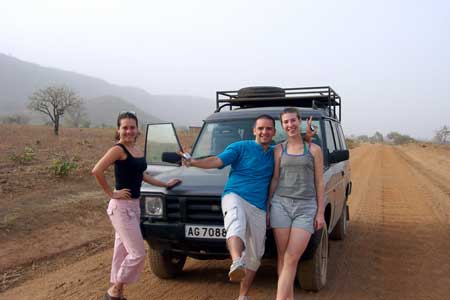North to the Sahel

I was glad to be leaving Cotonou as we rumbled northward in the already warm early morning air. It’s easy to get lost in Africa’s capital cities while the bulk of Africa lies elsewhere in a form that’s so distinct and so vibrant. We were headed to Pendjari National Park, to see some wildlife and catch a glimpse of life in the Sahel, the vast, semi-arid zone that forms the transition between the moist tropical coastline and the breathtaking Sahara.
We departed with two friends from Colombia and France, taking turns at the wheel of our fantastic Land Rover Adventuremobile as we worked our way up the latitude lines of my map. But every map I’ve ever seen of Africa resorts to ruse in order to fit the continent on a conveniently-sized sheet of paper. Africa is unspeakably immense, and even tiny Benin wedged against the Atlantic coast is bigger than it looks. Pendjari park lies against the Burkina Faso border in northwest Benin, and is a full 700 kilometers from Cotonou, and a decent ten hours of driving.
We pressed north through a fatigued landscape that bleached from the torpid greenery of the Atlantic coast to the the dusty savannah of the African Sahel, uninterrupted except for the occasional rural village and a pair of rocky hillsides outside of Savalou that rose like snaggle teeth from among the grasses and threw the town into shadow. The road was a gorgeous strip of modern engineering, rebuilt sometime around 2003, broad and black and smooth, a trans-African expressway along which limped the sorry carcasses of the West African truck fleet. As best as I could tell, one in three trucks had broken down roundly in the travel lane or torn itself to metal shreds in violent, self-destructive accidents that left mangled iron carcasses in the ditches. The drivers of broken-down vehicles placed bouquets of leafy tree branches, warning other travelers to slow down and avoid striking the stationary vehicles until they were coaxed back to life a day or a week later. Malian tankers with threadbare inner tires crept painfully in both lanes, Beninese cotton trucks piled three meters over the top straggled on misaligned carriages like mangy mutts; Burkinabe box trucks leaned dangerously to one side, awaiting the breath of savannah wind that would topple them over and spread their contents over the valley. And we passed several shredded vehicles that had done just that, spillling their guts – cotton, rice sacks, gasoline – all over the road.

On both sides the land was the color of paprika and cinnamon. Roadside villages of earthen homes squatted around cleared patches worn smooth by decades of tramping of bare feet. The houses had been built of the same soil, slowly baked into bricks and stacked in layers that rose to thatched roofs. The color of the soil leached upwards into the walls, giving the impression the homes were just natural extensions of the earth itself, as if a single good rainstorm could push them back into the ground and remove all trace of human existence.
We passed through poor regions of people living exceptionally simple lifestyles, but the poverty wasn’t shocking; rather it was sobering to imagine how hard it must be to shake crops out of those thin red soils that seemed scarcely able to sustain their thin grassy scalps. People seemed to be living about as well as you could hope for given the unforgiving landscape.
Besides the stalky fields of cotton, now harvested and bound in trucks for the port in Cotonou, we drove through stippled fields of mounded manioc and yams, each plant rising solitarily from a single molded cone of soft earth. No wonder then, that many Africans seemed to turn to the forests for their livelihood. Charcoal was a major source of income along much of the roadside that led from Cotonou north through Abomey, Dassa, Savalou, Banté, Djougou, and Natitingou. Full flour sacks of ebony charcoal stood attention in columns by the roadside like Russian dolls while fires smoldered under lumps of hot earth. Beside them stacks of dried cordwood awaited purchasers bound for the drier points further north at the Sahara’s edge.
But everywhere, without exception, people at the roadside smiled and waved at us, and somehow, we felt strangely at home.
Trackbacks
The author does not allow comments to this entry

Comments
Display comments as Linear | Threaded